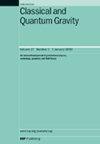关于协变和正则哈密顿形式:弱孤立视界
IF 3.7
3区 物理与天体物理
Q2 ASTRONOMY & ASTROPHYSICS
引用次数: 0
摘要
经典规范理论的哈密顿描述是一个研究得很好的课题。两种最著名的方法,即协变和正则哈密顿形式,在文献中得到了很多关注。对二者之间的关系也进行了广泛的分析。然而,对这种关系的完全理解仍然是不可用的,特别是对于在有边界的区域上定义的规范理论。在这里,我们考虑这个问题,对于具有孤立视界作为内部边界的时空(代表处于平衡状态的黑洞),并评估它们相应的描述是否可以被视为等效的。首先,我们重新回顾和重新分析了这两种形式,并表明,如果我们从表面上比较它们,它们之间存在差异,例如在视界能量的推导中,理论的物理观察,以及边界自由度的数量。在这里,我们构建和比较相应相空间的可能扩展,以一种以前没有探索过的方式。我们分析了两种方法中不同的可能解释,并展示了如何在协变和规范形式中实现结果之间的对应。在此过程中,我们阐明了边界项在辛结构中与边界自由度有关的作用。本文章由计算机程序翻译,如有差异,请以英文原文为准。
On covariant and canonical Hamiltonian formalisms: weakly isolated horizons
The Hamiltonian description of classical gauge theories is a well studied subject. The two best known approaches, namely the covariant and canonical Hamiltonian formalisms, have received a lot of attention in the literature. The relation between them has also been extensively analyzed. However, a complete understanding of this relation is still not available, specially for gauge theories that are defined over regions with boundaries. Here we consider this issue, for spacetimes with isolated horizons as inner boundaries (representing black holes in equilibrium), and assess whether their corresponding descriptions can be seen as equivalent. First, we review and reanalyze both formalisms from anew and show that, if we compare them at face value, there are differences between them, for instance in the derivation of horizon energy, a physical observable of the theory, as well as in the number of boundary degrees of freedom. Here we construct and compare possible extensions of the corresponding phase spaces, in a way that has not been explored before. We analyze different possible interpretations in both approaches and show how one can achieve correspondence between results within covariant and canonical formalisms. Along the way, we shed light on the role of boundary terms in the symplectic structure in relation to boundary degrees of freedom.
求助全文
通过发布文献求助,成功后即可免费获取论文全文。
去求助
来源期刊

Classical and Quantum Gravity
物理-天文与天体物理
CiteScore
7.00
自引率
8.60%
发文量
301
审稿时长
2-4 weeks
期刊介绍:
Classical and Quantum Gravity is an established journal for physicists, mathematicians and cosmologists in the fields of gravitation and the theory of spacetime. The journal is now the acknowledged world leader in classical relativity and all areas of quantum gravity.
 求助内容:
求助内容: 应助结果提醒方式:
应助结果提醒方式:


